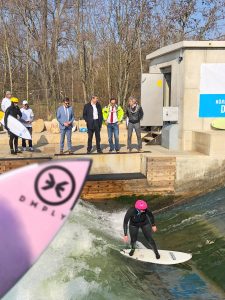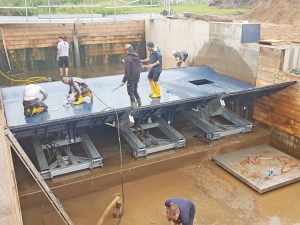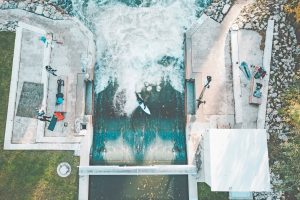Nuremberg ‘Fuchslochwelle’: A new face in urban sport
Anyone who takes surfing seriously knows it takes far more than a board and a broad smile. Stamina, focus and the readiness to skilfully adapt to changing conditions are essentials. The southern-German river surfing community has shown just what can be achieved by realising projects such as the recently-opened ‘Fuchslochwelle’. The relatively new sport of river surfing is now trending. Increased environmental awareness has led to a more critical view of long-distance flights to the classic surfing destinations of the world. Attention has turned to the possibilities provided by regional venues, and to the question of how to exploit them sustainably. In keeping with this line of thinking, the project was realised by local companies: The Bavarian hydraulic steel component manufacturers Erhard Muhr GmbH, and the Rhineland civil engineering office, Dreamwave GmbH, a business in close cooperation with the University of Innsbruck. River surfers know what it’s like to jump into cold water; and now these two businesses know the feeling too – this being the world’s first installation of its kind.
The ceremonial opening of the Fuchslochwelle stationary wave facility on the 25th February 2022 marked the keeping of a promise made to the southern-German river surfing community by the Nürnberger Dauerwelle e.V. association over 10 years ago: The promise was to build a stationary wave in the heart of the city as a place for N.D. e.V. members to train and an easily accessible facility for the public to try the sport. Over ten years of planning, convincing politicians and more than 2000 hours of voluntary work were invested in the Fuchslochwelle. The centrepiece of the facility is the standing wave, integrated into a channel built parallel to the main arm of the river. The weir required to create a build-up of water and the fishway were integrated into the original Pegnitz riverbed. The weir and wave ramp can be set up independently of one another in reaction to the natural fluctuations in flow volumes along the river. The facility design guarantees a stable water level further upstream, as well as the creation of various types of waves. The structural designs for this standing wave were developed and patented by Dreamwave GmbH. The wave was built by Erhard Muhr GmbH, also responsible for the layout of the surrounding wave production engineering, manufacture of the dam gates, the complex hydraulics set-up and sophisticated control system. The association’s new sports and leisure infrastructure is a non-commercial contribution to the encouragement and diversification of activity in a publicly-accessible local urban area. However, development of a technical concept was required to adapt the facility to the variety of river-flow conditions in order to make it available throughout the year.

© Muhr
Numerous set-up options
Lasse Bauer, Dreamwave engineer and surfer, explains the basic principle behind the standing wave facility: “The wave infrastructure consists of three modules, each with three main components: a segment, a plate and a kicker. The segments hold back the water, the plates determine the water-speed transition from ‘flowing’ to ‘shooting’. The water accelerates down the plate until it shoots over the kicker to guarantee the ideal direction of the ultimate jet. The water flows in a similar way as it does into a dissipation basin, the key difference being that we manipulate the hydraulic jump to create a wave ideal for surfing purposes.”
There is no other modular arrangement like this in the world. Dreamwave and Erhard Muhr GmbH broke new ground with this construction. Lasse Bauer explains it was the love of river surfing that drove them to set the bar so high: “We wanted to give anyone using the facility as many wave options as possible. Normally the standing wave system runs in a three-module mode and produces a ‘standard wave’. The automated water level regulation adapts to the prevailing conditions, such as water level and descending water flow volumes. An app enables the standard wave to be shaped to suit the wishes of the surfer. Two-module operation allows the wave to modelled in a way that enables the system to compensate for lower flow rates, significantly extending the period during which the standing wave can be used.” Climbing in is made easier for beginners by regulating the rate of flow. If considerably less water flows into the wave system, the wave produced is less extreme.
Rethinking familiar principles
Erhard Muhr GmbH was responsible for manufacturing the entire stationary wave infrastructure and the company is proud of the results. Fabian Böttger, Muhr’s project manager in Nuremberg, was delighted to have contributed many years of hydraulic steel construction expertise to a completely new product and project: “The variety of our projects and customers we serve qualified us for this project. Our readiness to find viable, load-bearing solutions for all the unanswered questions, and to think issues through to the end are what won us this contract. We are delighted that, alongside sustainable energy production, we now have green sport in our portfolio.” Particular praise was found for the collaboration between Muhr and Dreamwave, each having brought all their own special strengths to the table. A mock-up of the construction concept devised by Dreamwave was tested using scale models in the flow channel. The forces affecting the various components in a whole variety of flow situations enabled Muhr to draught a full-scale layout. Fabian Böttger outlined procedures: “Our hydraulic steel construction solutions are nearly always created in two planning steps. The data Dreamwave provided formed the basis for our calculations regarding the forces acting upon the future components, and for their corresponding dimensions. The production process was then planned, organised and all the components manufactured.”

The companies Muhr and Dreamwave joined forces with the surf club members to complete the new standing wave.
© Muhr
Environmentally sustainable water sports for all
In contrast to wave generators that consume large amounts of energy to create waves in pools, the main source of energy for Nürnberger Dauerwelle e.v. is the river itself. Another demand was to ensure the conditions in the immediate area were altered as little as possible. The channel in which the wave modules are located was built parallel to the main run of the river, so of course the fishway and weir have also been integrated into the natural course of the river. The entire facility permits river life to enjoy access up and downstream. The fishway brushes also enable boats and kayaks to navigate the channel, so there’s unrestricted passage for the river’s fish population, and for other leisure-time river users.
A new corner of Franconia
The ‘Fuchslochwelle’ is the proud result of stamina, willpower and skill, and allows this Franconian city to promise even greater quality-of-life. Muhr’s Fabian Böttger is delighted with the project: “The collegial collaboration between the numerous groups involved in the project made this joint success possible.” Congratulations at the ceremonial opening came from Bavaria’s Minister President, Markus Söder, from the Mayor of Nuremberg Marcus König, and Markus Aufleger – CEO Dreamwave GmbH. There is now collaboration with Erhard Muhr GmbH on subsequent projects in several German cities, including Hanover and Augsburg.

Training activity at the new river wave facility.
© Andi Schiefer — “It’s nice out there.”
An overview of the steps and requirements involved in constructing the Fuchslochwelle
Selection of materials and coatings
• Seven types of steel were used, each suited to the requirements for thecomponent in question.
• Permanently-operating underwater rust-free, leak-free hydraulic cylinders, made with suitable materials and coatings, and fitted with sensor technology.
• Choice of suitable lubricants and bearing materials for uninterrupted underwater operation.
• Each module to be completely sealed from the overall structure and the other modules.
Layout of the individual components
• Conversion of forces calculations for material stress loads and a selection of suitable raw materials and formats, at all times in adherence with the site dimensions provided and the available budget.
• Extreme care required for the positioning of the bearing mountings between the individual components – which need to be mobile within their intended spaces.
Dimensioning of connecting and welding parameters
• An absolutely smooth surface was required for surfing purposes. Special developmental consideration had to be given to the producing, welding and mounting of an extremely rigid and sturdy carrier structure capable of withstanding the powerful forces involved.
High standards set for the hydraulics
• The set-up feeds 14 hydraulic cylinders in constant operation and requires very precise positioning.
• Operation of the hydraulics and controls is guaranteed by buffer storage to cover the risk of power failure. This is essential for the safety of those
using the wave facility, and in line with the regulations issued by the local authorities.
Sophisticated control technology required
• A major challenge for controlling the set-up was posed by the interaction of weir and water, since the system employs two regulative elements that mutually affect each other. The strict directives issued by the authorities state that the standing wave infrastructure must always guarantee the required water storage level, whether in operation or not.
General safety standards
• The highest safety standards apply, since the wave infrastructure is installed for sporting purposes and is in direct contact with the people who use it.
• The manufacturers developed a proprietary emergency stop function to allow flow rates to be reduced to a safe level very quickly. The modules go into a kind of standby-by mode to allow surfers in trouble to be helped.
Assuring accessibility for component installation and maintenance
• The facility includes a maintenance window for entry into the installation and a safety bolt to secure anyone servicing the infrastructure.
• Points of separation and sectional links have been integrated to allow worn-out parts to be replaced without a full facility removal.
Extremely efficient construction procedures
• The fact much of the structure had to be preassembled in the factory, where a subsequent comprehensive inspection was required prior to transportation, all enabled on-site installation and commissioning to be completed very rapidly.
• The lack of other technical infrastructure obstructing integration meant the entire installation procedure could be conducted quickly and easily.